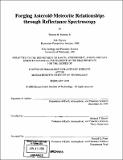Forging asteroid-meteorite relationships through reflectance spectroscopy
Author(s)
Burbine, Thomas H. (Thomas Hewey), 1966-
DownloadFull printable version (13.76Mb)
Other Contributors
Massachusetts Institute of Technology. Dept. of Earth, Atmospheric, and Planetary Sciences.
Advisor
Richard P. Binzel.
Terms of use
Metadata
Show full item recordAbstract
Near-infrared spectra (~0.90 to ~1.65 microns) were obtained for 196 main-belt and near-Earth asteroids to determine plausible meteorite parent bodies. These spectra, when coupled with previously obtained visible data, allow for a better determination of asteroid mineralogies. Over half of the observed objects have estimated diameters less than 20 k-m. Many important results were obtained concerning the compositional structure of the asteroid belt. A number of small objects near asteroid 4 Vesta were found to have near-infrared spectra similar to the eucrite and howardite meteorites, which are believed to be derived from Vesta. These asteroids appear almost certainly to be fragments of Vesta. Spectral variations between these objects are consistent with being primarily due to differences in particle size. These asteroids also tend to have stronger band depths with increasing ejection velocity from Vesta. Objects with distinctive olivine bands appear to provide definitive evidence that spectral alteration is occurring in the asteroid belt. These objects have similar band depths but appear significantly reddened relative to measured olivine samples due to their significantly higher reflectance values with increasing wavelength. The only laboratory-simulated "weathering" process that reddens the spectra but does not significantly suppress the bands is alteration by laser irradiation, which is hoped to duplicate the effects of micrometeorite bombardment. A number of plausible main-belt parent bodies were identified. These include 19 Fortuna and the CM chondrites, Eos family members with the CO chondrites and 599 Luisa with the CV chondrites. A significant fraction of S asteroids have spectral properties that range from similar to ordinary chondrites to much redder with weaker absorption bands. These objects tend to have spectra consistent with a mixture of ordinary chondrite material and metallic iron. However, other alteration processes cannot be ruled out. Asteroids with distinctive olivine bands are relatively rare. The available evidence is consistent with a scenario where, with the exception of Vesta, all differentiated bodies were either disrupted or had their mantles stripped very early in the age of the solar system. Olivine-rich metal-free fragments were then continually broken down until they almost all now fall below our current astronomical measurement limits.
Description
Thesis (Ph.D.)--Massachusetts Institute of Technology, Dept. of Earth, Atmospheric, and Planetary Sciences, 2000. Includes bibliographical references (p. 225-248).
Date issued
2000Department
Massachusetts Institute of Technology. Department of Earth, Atmospheric, and Planetary SciencesPublisher
Massachusetts Institute of Technology
Keywords
Earth, Atmospheric, and Planetary Sciences.